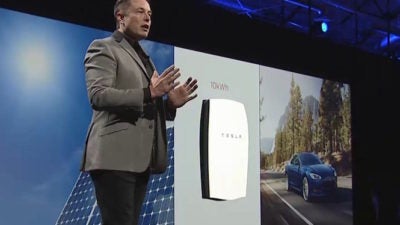Pairing solar and batteries part two: PowerWall

(This article was written by Tobi Ogunnaike, a 2015 summer fellow)
In part one, we looked at the growing interest in pairing solar and storage. Much of this interest has been sparked by the introduction of Tesla’s PowerWall battery.
Technologically, the PowerWall is nothing revolutionary – battery makers have been using lithium ion chemistry to store energy for quite some time.
From a design point of view, it is a thing of undeniable beauty. Pre-PowerWall, batteries were ugly and rightfully shunned to the shadows. But the PowerWall is designed to be appear inviting and sleek. The design plus the large amount of publicity that accompanied its announcement has created excitement and lots of free press for the entire battery industry.
From a price perspective, $3500 for 10 kWh may seem cheap initially, but this price does not include the cost of an inverter and of installation. This may double your bill. The average American house loses power for about two hours a year. From that perspective, paying $7,000 for an extra two hours of power a year is an expensive proposition.
Who does it make sense for?
Even if we won’t see everyone buying a PowerWall, or similar battery storage, there are markets and customers for which the PowerWall makes sense. If you live in an area with high electricity costs or have very unreliable power then solar paired with a relatively cheap battery (PowerWall or other) could be suitable for you now away.
Similarly, if you live in a state where net-metering is not allowed (not an issue in the District), then the PowerWall could be a good solution for you. It would help you make more use of the energy your panels generate. You would be able to store your energy for later use.
Early indications suggest that the PowerWall will not be suitable for many homeowners in the US. Elon Musk himself said that up to 70% of their battery orders are for the bigger, commercial scale (100 kWh) PowerPack batteries that businesses have been rushing to buy.
Likewise, foreign markets such as Germany where net metering does not exist appear prime for the taking. 100,000 reservations potentially worth $1 billion is testament to the promise of both battery products.
Step in the right direction
The smaller, residential size PowerWall is an important step in the right direction. Before Elon Musk’s announcements, the general public did not discuss energy storage widely, and certainly not with any fervor. But now, we have significant interest in the future of the market – products, technologies and prices. Everybody is watching. This scrutiny will only serve to intensify the efforts of Tesla Energy and other innovative battery manufacturers.
Together, the actions of these companies will move us closer to a potential shift in how homeowners consume energy and to a cleaner energy economy.
